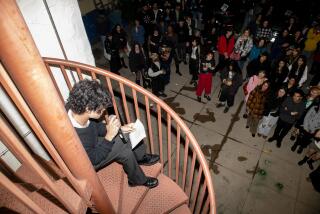Book Review : Pieces of Life Don’t Fall Into Place
Tuxedo Park by Laura Furman (Summit: $17.95)
The marriage of Sadie Ash and Willard Weaver is a mismatch made in heaven--not for the principals, but for the reader. Beginning with the now classic theme of the effects of a disintegrating marriage upon parents and children, Furman has carefully separated the elements from their usual context and reassembled them against a highly colored background. The result is a collage in which familiar pieces fall into surprising configurations; their shape and form radically altered by juxtaposition and setting.
Most of the novel takes place in Tuxedo Park, once so fashionable a resort that when the residents appeared in tailless dinner coats, the style immediately became part of the language. Unfortunately for such special enclaves, the year has only four seasons, and the well-born and bred for whom Pierre Lorillard designed his exclusive community eventually found themselves too busy with July in Newport, August in Saratoga, winter in New York and spring in Europe to spend much time in the New Jersey boondocks.
The shingled lodges, built for autumn hunting and fishing parties, became only a waystation “where people came in between the places they really wanted to be. Too hot in summer, too isolated in winter.” Some of the empty houses burned, others were sold to people Lorillard would never have approved for membership in the Tuxedo Park club. Now the village is merely a part of the commuter strip lining both sides of the Hudson River, its original identity all but lost in suburban sprawl.
When Sadie Ash first saw the place, just after the end of World War II, she was enchanted. Like Willard Weaver himself, Tuxedo Park seemed rare and special, representing the epitome of elegance and security, qualities sadly lacking in Sadie’s life. Since the death of her parents in an auto accident when she was 12, she had been living with her older brother in the family’s New York apartment, an affectionate but unsatisfactory arrangement for both; a limbo in which Reuben Ash waited for Sadie to grow up before embarking on a life of his own.
As the book opens, Sadie is still an immature college student, dreaming of romance; Reuben has put his emotional life on indefinite hold. When Willard Weaver, handsome, artistic, well-off and nearly 30, finds Sadie skating in Rockefeller Center, he seems to present a kind of salvation.
They had met a year or so earlier in art class, then lost track of one another until this apparently chance encounter. Beguiled by Willard’s veneer of sophistication; totally vulnerable to his superficial charm, Sadie falls immediately and permanently in love. Aware of his own inadequacies, Willard regards Sadie as an agreeable diversion, enjoying the contrast of her vitality and energy to his own listlessness. Though he doesn’t expect to marry her, when she becomes pregnant, he willingly accedes, and for a while, the vibrant Jewish girl and the wan WASP seem to complement one another. As far as Sadie is concerned, the marriage is a success. If Willard seems remote and uninterested in her or their two little daughters, she dismisses his coldness as a temperamental difference, doing her best to make up for it with her own enthusiasm.
At first reluctant to leave New York for a sojourn in the Weavers’ decaying Tuxedo Park house, Sadie becomes deeply attached to the place, and when Willard informs her that he’s leaving the family “to be free,” she insists upon staying on in the country mansion, surprising herself as much as Willard. Despite all evidence to the contrary, Sadie believes that Willard’s desertion is only temporary. By establishing herself in Tuxedo Park, that bastion of Weaver tradition, she is able to persuade herself that he’ll eventually return. With the help and support of congenial neighbors, as lost in their particular ways as she is, Sadie invents a reasonably happy life for herself and the girls, while Willard continues to drift aimlessly. Resuming a relationship with a previous lover, he passively allows it to reach a point where remarriage seems essential. Adamantly refusing to grant him a divorce, Sadie unconsciously recreates the limbo in which she spent her adolescence, waiting now for her real life to resume as she once waited for it to begin.
Busy with her garden and her two close friends, Sadie has insulated herself against reality. Unaware that her older child has been living in a dangerous fantasy world, she’s finally shocked into confronting the truth about her sham marriage. Once forced out of her isolation by her daughter’s melodramatic gesture, she emerges from her self-imposed exile far better prepared for life than anyone might have expected. Wry and not in the least sentimental, “Tuxedo Park” is both gentle social satire and incisive social commentary.
More to Read
The biggest entertainment stories
Get our big stories about Hollywood, film, television, music, arts, culture and more right in your inbox as soon as they publish.
You may occasionally receive promotional content from the Los Angeles Times.










